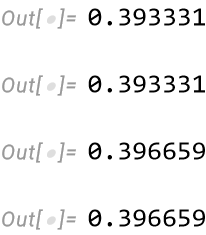Update 1:
Here we only verified numericallyprovide a large-$n$ approximation of the result $(1)$. We define auxiliary functions as:
\begin{eqnarray} P^{(h,\sigma)}_1(y)&=&\frac{ h \sigma ^2 \sqrt{\frac{\left(h^2+\sigma ^2\right)^3}{h^2 \sigma ^4}} \left(h^4+h^2 y^2-\sigma ^4\right)}{2 \left(h^2+\sigma ^2\right)^{7/2}} \\ P^{(h,\sigma)}_2(y)&=&\frac{\left(5 h^8+h^6 \left(13 \sigma ^2+2 y^2\right)+h^4 \left(15 \sigma ^4+y^4+\sigma ^2 y^2\right)+h^2 \left(11 \sigma ^6-\sigma ^4 y^2\right)+4 \sigma ^8\right)}{8 \left(h^2+\sigma ^2\right)^4} \\ \vdots \end{eqnarray}
And now we are ready to give the result. Here you go:
\begin{eqnarray} &&{\mathfrak f}_{2n-1}^{(y,h,\sigma)} = \frac{ \exp\left(+\frac{h^2 (2 n-1)-y^2}{2 \sigma^2}\right) 2^{1} \left(\frac{h^2 (2 n-1)}{2\sigma ^2}\right)^n} { h (n-1)!} \cdot \\ && % \int\limits_0^1 \frac{ \exp \left( \frac{h^2}{2 \eta ^2 \sigma ^2}+\frac{\eta ^2 y^2}{2 \sigma ^2}\right) \cdot % % % } {\left(1-\eta ^2\right)} \cdot \exp\left[ n \left( \log\left(\frac{1-\eta ^2}{\eta ^2}\right) -\frac{h^2}{\eta ^2 \sigma ^2}\right) \right] d\eta \\ &&\simeq \frac{ \text{sgn}(h) \cdot e^{-\frac{y^2}{2 \left(h^2+\sigma ^2\right)}} }{ \sqrt{h^2+\sigma ^2} } \cdot % \underline{ \frac{\sqrt{2 \pi } \left(n-\frac{1}{2}\right)^n e^{-n+\frac{1}{2}}}{\sqrt{n} (n-1)! } } % \cdot \\ && \underline{\underline{ \int\limits_{-\frac{2 h \sqrt{\frac{n \left(h^2+\sigma ^2\right)^3}{h^2 \sigma ^4}}}{\sqrt{h^2+\sigma ^2}}}^{2 \left(1-\frac{h}{\sqrt{h^2+\sigma ^2}}\right) \sqrt{\frac{n \left(h^2+\sigma ^2\right)^3}{h^2 \sigma ^4}}} % \frac{e^{-\frac{\eta ^2}{2}}}{ \sqrt{2 \pi }} \cdot % \left(1+P^{(h,\sigma)}_1(y)\cdot \frac{\eta}{\sqrt{n}}+ % P^{(h,\sigma)}_2(y) \cdot \frac{\eta ^2}{n} +O(\frac{\eta^3}{n^{3/2}}) \right) % d\eta }} \end{eqnarray}
In the second line we expanded (to the second order) both the first term in the integrand and the term in the parentheses in the exponential about the stationary point $\eta_* := h/\sqrt{h^2+\sigma^2}$ and then we simplified the result. Note that in the limit $n \rightarrow \infty$ both the underlined and the doubly underlined terms go to unity and as such we the result is $\lim_{n\rightarrow \infty} {\mathfrak f}_{2n-1}^{(y,h,\sigma)} = \frac{ \text{sgn}(h) \cdot e^{-\frac{y^2}{2 \left(h^2+\sigma ^2\right)}} }{ \sqrt{h^2+\sigma ^2} }$ as expected.
\begin{equation} \lim_{n \rightarrow \infty} {\mathfrak f}_{2n-1}^{(y,h,\sigma)} = \frac{e^{-\frac{y^2}{2 \left(h^2+\sigma ^2\right)}}}{\sqrt{h^2+\sigma ^2}} \end{equation} Again, the code snippet below verifies all the steps numerically:
{h, y, \[Sigma]} = RandomReal[{1, 2}, 3, WorkingPrecision -> 50];
n = RandomInteger[{10, 15}];
b = 2 n - 1;
CC = h y/(Sqrt[2] \[Sigma]^2);
( 2^1 E^(((2 n - 1) h^2 - y^2)/(
2 \[Sigma]^2)) (((2 n - 1) h^2)/(2 \[Sigma]^2))^n)/(h (-1 + n)!)
NIntegrate[((-\[Eta]^2 + 1)/\[Eta]^2)^n E^((
y^2 \[Eta]^4 - (2 n - 1) h^2)/(2 \[Eta]^2 \[Sigma]^2))/(
1 - \[Eta]^2) , {\[Eta], 0, 1}]
( 2^1 E^(((2 n - 1) h^2 - y^2)/(
2 \[Sigma]^2)) (((2 n - 1) h^2)/(2 \[Sigma]^2))^n)/(h (-1 + n)!)
NIntegrate[E^(
h^2/(2 \[Eta]^2 \[Sigma]^2) + (y^2 \[Eta]^2)/(2 \[Sigma]^2) +
n (-(h^2/(\[Eta]^2 \[Sigma]^2)) + Log[(1 - \[Eta]^2)/\[Eta]^2]))/(
1 - \[Eta]^2) , {\[Eta], 0, 1}]
(*Stationary phase approximation.*)
( 2^1 E^(((2 n - 1) h^2 - y^2)/(
2 \[Sigma]^2)) (((2 n - 1) h^2)/(2 \[Sigma]^2))^n)/(h (-1 + n)!) (
E^((h^4 + \[Sigma]^4 + h^2 (y^2 + 2 \[Sigma]^2))/(
2 \[Sigma]^2 (h^2 + \[Sigma]^2))) (h^2 + \[Sigma]^2))/\[Sigma]^2 \
NIntegrate[(1 + (7/2 + y^2 (h^2/\[Sigma]^4 - 1/(2 \[Sigma]^2)) + (
5 h^4)/(2 \[Sigma]^4) + (4 h^2)/\[Sigma]^2 + (2 \[Sigma]^2)/
h^2 + (h^2 y^4)/(2 \[Sigma]^4 (h^2 + \[Sigma]^2))) (\[Eta] -
h/Sqrt[h^2 + \[Sigma]^2])^2 + (\[Eta] - h/Sqrt[
h^2 + \[Sigma]^2]) ((
h y^2)/(\[Sigma]^2 Sqrt[
h^2 + \[Sigma]^2]) + ((h^2 - \[Sigma]^2) Sqrt[
h^2 + \[Sigma]^2])/(h \[Sigma]^2))) E^(
n ((-h^2 - \[Sigma]^2)/\[Sigma]^2 - (
2 (h^2 + \[Sigma]^2)^3 (\[Eta] - h/Sqrt[h^2 + \[Sigma]^2])^2)/(
h^2 \[Sigma]^4) + Log[\[Sigma]^2/h^2])) , {\[Eta], 0, 1}]
(Sign[h] E^(-y^2/(2 (h^2 + \[Sigma]^2))))/(h^2 + \[Sigma]^2)^(1/2) (
Sqrt[2 \[Pi]] (E^(-n + 1/2)) (( -(1/2) + n)^n) )/( (-1 + n)! Sqrt[
n]) NIntegrate[(1 + (\[Eta])^2 (
5 h^8 + 4 \[Sigma]^8 + h^6 (2 y^2 + 13 \[Sigma]^2) +
h^4 (y^4 + y^2 \[Sigma]^2 + 15 \[Sigma]^4) +
h^2 (-y^2 \[Sigma]^4 + 11 \[Sigma]^6))/(
8 n (h^2 + \[Sigma]^2)^4) + (\[Eta]) (
h \[Sigma]^2 Sqrt[(h^2 + \[Sigma]^2)^3/(
h^2 \[Sigma]^4)] (h^4 + h^2 y^2 - \[Sigma]^4))/(
Sqrt[4 n] (h^2 + \[Sigma]^2)^(7/2)) ) E^(-1/2 (\[Eta])^2)/Sqrt[
2 \[Pi]] , {\[Eta], -(h/Sqrt[h^2 + \[Sigma]^2]) Sqrt[(
4 n ((h^2 + \[Sigma]^2)^3) )/(
h^2 \[Sigma]^4)], (-(h/Sqrt[h^2 + \[Sigma]^2]) + 1) Sqrt[(
4 n ((h^2 + \[Sigma]^2)^3) )/(h^2 \[Sigma]^4)]}]
 $n$ limit of the integral in question." />
$n$ limit of the integral in question." /> $n$ approximation." />
$n$ approximation." />

